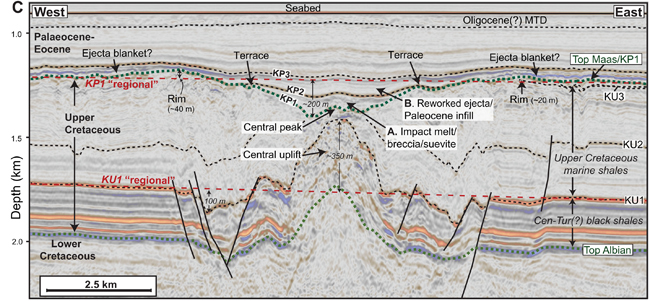Newly Described Impact Crater in the Atlantic Might be Linked to Chicxulub Impact Event (New Study)
Researchers have found evidence of an extraterrestrial impact crater buried in sediments under the North Atlantic. The 5-mile-wide (8.5 km wide) crater, was caused by the impact of a bolide (crater forming body), at least 400 metres across. Detailed stratigraphic analysis indicates the crater was created at or very near the Cretaceous/Palaeogene boundary around 66 million years ago. This would make this collision potentially contemporaneous to the Chicxulub impact event. The scientists postulate that this impact was caused as part of a closely timed impact cluster or by the breakup of a common parent bolide.

Buried Below the Seabed
The crater is buried 300 to 400 metres below the seabed some 250 miles (400 km) off the cost of the west African country of Guinea. Writing in the academic journal “Science Advances”, the researchers from Heriot-Watt University (Edinburgh), the University of Texas at Austin and the University of Arizona think that this impact occurred at around the same time as the Chicxulub impact that has been linked to the end Cretaceous extinction event that wiped out the non-avian dinosaurs.
To prove their theory, seabed core samples will have to be taken from the site. Lead author Dr Uisdean Nicholson, a geologist at Heriot-Watt University, has already applied for funding to drill into the seabed to confirm that it’s a bolide impact crater and establish the precise age.

Evidence of Impacts Extremely Rare
Evidence for extraterrestrial impact events is rare on planet Earth. Our dynamic geology and the effects of weathering have removed much of the physical evidence of even the largest bolide impact events in our planet’s long history.
However, for Dr Nicholson, seismic reflection data from the seabed immediately highlighted an unusual and unexpected geological anomaly.
Dr Nicholson explained:
“I’ve interpreted lots of seismic data in my time but had never seen anything like this. Instead of the flat sedimentary sequences I was expecting on the plateau, I found an 8.5 km depression under the seabed, with very unusual characteristics. It has particular features that point to an asteroid. It has a raised rim and a very prominent central uplift, which is consistent for large impact craters. It also has what looks like ejecta outside the crater, with very chaotic sedimentary deposits extending for tens of kilometres outside of the crater.”
This strange feature has been named the Nadir Crater, after a nearby seamount that lies to the west.
Other potential causes for this geological feature have already been discounted, Dr Nicholson added:
“The characteristics are just not consistent with other crater-forming processes like salt withdrawal or the collapse of a volcano.“
Impact Crater Potentially Linked to the Chicxulub Impact Event
The researchers suggest that the newly discovered Nadir crater could have formed by the break-up of a parent extraterrestrial body or from a series of Earth collisions by bolides.
Co-author Dr Sean Gulick, (University of Texas at Austin), stated:
“The Nadir Crater is an incredibly exciting discovery of a second impact close in time to the Cretaceous–Palaeogene extinction. While much smaller than the extinction causing Chicxulub impactor, its very existence requires us to investigate the possibility of an impact cluster in the latest Cretaceous.”

Devastation of the Region
The researchers ran computer simulations in a bid to assess the consequences of an impact from a 400-metre-wide body crashing into water around 500 metres deep. The researchers suggest that the impact would have generated a tsunami over 1,000 metres high and an earthquake of 6.5 magnitude. Such forces would have had caused devastation.
Everything Dinosaur acknowledges the assistance of a media release from Heriot-Watt University and the open access paper published in Science Advances in the compilation of this article.
The scientific paper: “The Nadir Crater offshore West Africa: A candidate Cretaceous-Paleogene impact structure” by Uisdean Nicholson, Veronica J. Bray, Sean P. S. Gulick and Benedict Aduomahor published in Science Advances.

